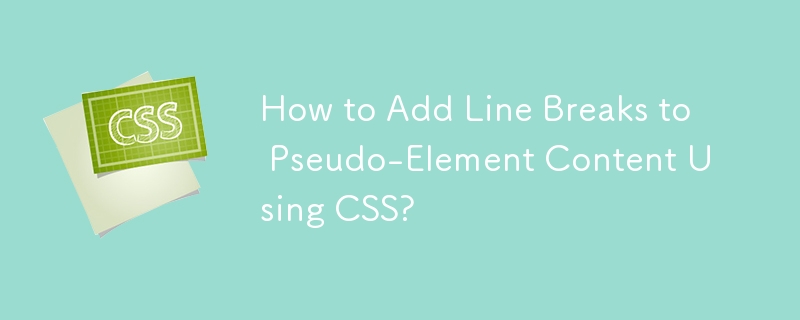

Menambah Pemisah Baris pada Kandungan Unsur Pseudo Menggunakan CSS
Pengenalan
Apabila menambah teks melalui ::selepas atau ::sebelum pseudo-elemen dalam CSS tanpa akses kepada HTML atau PHP, keperluan timbul untuk sertakan pemisah baris untuk kandungan berbilang baris. Artikel ini membincangkan cara untuk mencapai ini menggunakan CSS.
Menambah Pemisah Baris
Untuk menambah pemisah baris dalam sifat kandungan, gunakan jujukan melarikan diri "A". Walau bagaimanapun, pemisah baris yang disisipkan tertakluk pada sifat "ruang putih".
Contoh
Untuk menggambarkan, pertimbangkan kod berikut:
#headerAgentInfoDetailsPhone:after {
content:"Office: XXXXX \A Mobile: YYYYY ";
white-space: pre; /* or pre-wrap */
}Ini akan menambah pemisah baris selepas "XXXXX" dan memaparkan kandungan sebagai:
Office: XXXXX Mobile: YYYYY
Jujukan Melarikan Diri Alternatif
Jika anda menemui hasil yang tidak dapat diramalkan apabila menggunakan A, anda dinasihatkan untuk menggunakan 0000a. Ini memastikan bahawa rentetan arbitrari dilepaskan dengan betul.
Contoh Fungsi Escape
Untuk kemudahan, anda boleh menggunakan fungsi JavaScript berikut untuk melepaskan teks sembarangan dan menambahkannya pada CSS blok gaya:
function addTextToStyle(id, text) {
return `#${id}::after { content: "${text.replace(/"/g, '\"').replace(/\n/g, '\00000a')} }"`;
}Atas ialah kandungan terperinci Bagaimana untuk Menambah Pemisah Baris pada Kandungan Unsur Pseudo Menggunakan CSS?. Untuk maklumat lanjut, sila ikut artikel berkaitan lain di laman web China PHP!
 Perbezaan antara wlan dan wifi
Perbezaan antara wlan dan wifi
 Bagaimana untuk menyembunyikan sambungan fail
Bagaimana untuk menyembunyikan sambungan fail
 Penggunaan fungsi keluar dalam bahasa c
Penggunaan fungsi keluar dalam bahasa c
 penggunaan fungsi fungsi
penggunaan fungsi fungsi
 Kaedah penyulitan biasa untuk penyimpanan penyulitan data
Kaedah penyulitan biasa untuk penyimpanan penyulitan data
 Apakah fungsi rangkaian komputer
Apakah fungsi rangkaian komputer
 ralat mysql 10060
ralat mysql 10060
 Bagaimana untuk menukar tetapan antara sistem dwi Huawei
Bagaimana untuk menukar tetapan antara sistem dwi Huawei




